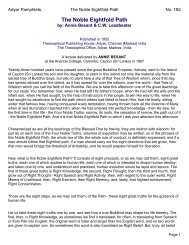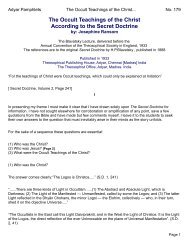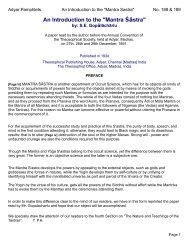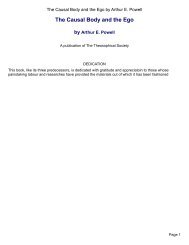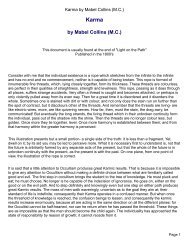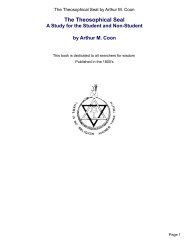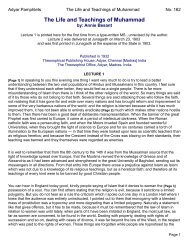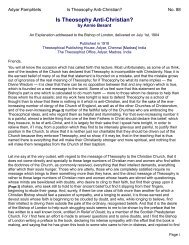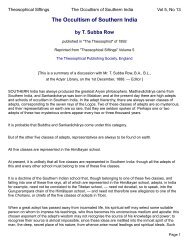Ancient Egyptian Magic and also Animated Statues
Ancient Egyptian Magic and also Animated Statues
Ancient Egyptian Magic and also Animated Statues
Create successful ePaper yourself
Turn your PDF publications into a flip-book with our unique Google optimized e-Paper software.
Adyar Pamphlets <strong>Ancient</strong> <strong>Egyptian</strong> <strong>Magic</strong> <strong>and</strong> <strong>also</strong> <strong>Animated</strong> <strong>Statues</strong> No. 39It is only in the "Dictionnaire des Religions" (Article on Fetichisme) that a pretty correct definition may befound: "The word fetich was derived from the Portuguese word fetisso, "enchanted", "bewitched" or"charmed"; whence fatum, "destiny", fatua, "fairy," etc.. Fetich, moreover, was <strong>and</strong> still ought to beidentical with "idol"; <strong>and</strong> as the author of "The Teraphim of Idolatry" says, "Fetichism is the adoration ofany object, whether inorganic or living, large or of minute proportions, in which, or, in connection withwhich, any 'spirit' — good or bad in short — an invisible intelligent power — has manifested itspresence."Having collected for my "Secret Doctrine" a number of notes upon this subject, I may now give some[Page 21] of them apropos of the latest Theosophical novel "A Fallen Idol", <strong>and</strong> thus show that work offiction based on some very occult truths of Esoteric Philosophy.The images of all the gods of antiquity, from the earliest Aryans down to the latest Semites — the Jews,— were all idols <strong>and</strong> fetiches, whether called Teraphim, Urim <strong>and</strong> Thummim, Kabeiri, or cherubs, or thegods Lares. If, speaking of the teraphim — a word that Grotius translates as "angels," an etymologyauthorized by Cornelius, who says that they "were the symbols of angelic presence"— the Christians areallowed to call them "the mediums through which divine presence was manifested," why not apply thesame to the idols of the "heathen"?I am perfectly alive to the fact that the modern man of science, like the average sceptic, believes no morein an "animated" image of the Roman Church than he does in the "animated" fetich of a savage. Butthere is no question, at present, of belief or disbelief. It is simply the evidence of antiquity embracing aperiod of several thous<strong>and</strong>s of years, as against the denial of the nineteenth century — the century ofSpiritualism <strong>and</strong> Spiritism, of Theosophy <strong>and</strong> Occultism, of Charcot <strong>and</strong> his hypnotism, of psychic"suggestion," <strong>and</strong> of unrecognized BLACK MAGIC all round.Let us Europeans honour the religion of our forefathers, by questioning it on its beliefs <strong>and</strong> their origin,before placing on its defence pagan antiquity <strong>and</strong> its [Page 22] gr<strong>and</strong> philosophy; where do we find inWestern sacred literature, so-called, the first mention of idols <strong>and</strong> fetiches? In chapter xxxi (et seq) ofGenesis, in Ur of the Chaldees in Mesopotamia, wherein the ancestors of Abraham, Serug <strong>and</strong> Terah,worshipped little idols in clay which they called their gods; <strong>and</strong> where <strong>also</strong>, in Haran, Rachel stole theimages (teraphim) of her father Laban. Jacob may have forbidden worship of those gods, yet one finds325 years after that prohibition, the Mosaic Jews adoring "the gods of the Amorites" all the same (Joshuaxxiv. 14, 15). The teraphim-gods of Laban exist to this day among certain tribes of Musulmans on Persianterritory. They are small statuettes of tutelary genii, or gods, which consulted on every occasion. TheRabbis explain that Rachel no other motive for stealing her father's gods than that of preventing hislearning from them the direction she <strong>and</strong> her husb<strong>and</strong> Jacob had taken, lest he should prevent them fromleaving home once more. Thus, it was not piety, or the fear of the Lord God of Israel, but simply a dreadof the indiscretion of the gods that made her secure them. Moreover, her m<strong>and</strong>rakes were only anotherkind of sortilegious <strong>and</strong> magical implements.Now what is the opinion of various classical <strong>and</strong> even sacred writers on these idols, which HermesTrismegistus calls "statues far-seeing futurity". (Asclepias)?Philo of Biblos shows that the Jews consulted demons like the Amorites, especially through small [Page 23]Page 8



